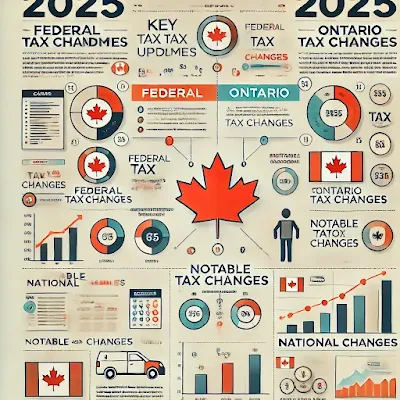Comprehensive Guide to 2025 Canada Tax Changes: What You Need to Know
As we step into 2025, Canada has introduced several significant changes to its tax laws that will impact individuals, families, and businesses nationwide. From updated income tax brackets to new provincial initiatives, these updates aim to address inflation, cost-of-living pressures, and environmental concerns. Here's an in-depth look at what these changes mean for you.
Federal Tax Changes
1. Adjusted Income Tax Brackets
To account for a 2.7% inflation rate, the Canada Revenue Agency (CRA) has revised federal income tax brackets. While the tax rates remain unchanged, the income thresholds have shifted as follows:
- 15% on the first $57,375 of taxable income
- 20.5% on the next $57,375 (from $57,375.01 to $114,750)
- 26% on the next $63,132 (from $114,750.01 to $177,882)
- 29% on the next $75,532 (from $177,882.01 to $253,414)
- 33% on income over $253,414
These adjustments prevent "bracket creep," ensuring inflation does not push taxpayers into higher tax brackets without an actual increase in purchasing power.
2. Tax-Free Savings Account (TFSA) Limit
For 2025, the annual TFSA contribution limit has increased to $7,000, providing Canadians with more room to grow their savings tax-free. This increase aligns with inflation trends and supports long-term financial planning.
3. Enhanced Canada Pension Plan (CPP)
CPP contribution rates have risen to 5.95% for both employees and employers, up from 5.70% in 2024. These adjustments support ongoing enhancements to the CPP, promising better retirement benefits for contributors.
4. Temporary GST/HST Suspension
From December 14, 2024, to February 14, 2025, the federal government has implemented a tax holiday on select items, including children’s clothing, toys, and groceries. This initiative provides temporary relief to families during the holiday season.
Ontario Provincial Tax Changes
1. Property Tax Increases
Several municipalities in Ontario, such as London, Hamilton, and Mississauga, are implementing steep property tax hikes for 2025. These changes reflect efforts to balance municipal budgets amidst rising costs.
2. Enhanced Childcare Tax Credit
The Childcare Access and Relief from Expenses (CARE) tax credit has been increased by 20%. This enhancement supports families with childcare expenses, making early education more accessible.
3. Property Tax Deferral Program for Seniors
Low-income seniors in Ontario can now defer their property tax payments. This program aims to ease the financial burden on elderly homeowners while allowing them to remain in their homes longer.
Other Notable Changes Across Canada
1. Increased Carbon Tax
The federal carbon tax has risen, increasing the cost of fossil fuels. To offset these costs, households receive rebates tailored to their province and family size. The move aims to reduce greenhouse gas emissions and accelerate the transition to greener energy sources.
2. Employment Insurance (EI) Premiums
The EI premium rate has increased to 1.65% for employees and 2.31% for employers. This adjustment ensures the sustainability of Canada’s EI program while addressing increasing demands.
3. Capital Gains Tax Changes
For gains exceeding $250,000 annually, the inclusion rate has increased to 67%. This change means that two-thirds of the profits from the sale of investments above this threshold are now subject to taxation.
FAQs
1. How do the new tax brackets affect my take-home pay?
The adjusted brackets mean you’ll pay the same tax rates on your income but with higher thresholds. For most Canadians, this adjustment prevents paying higher taxes due to inflation without earning more.
2. What is the benefit of the increased TFSA limit?
With a higher contribution limit, you can invest more money in a tax-sheltered account, allowing your investments to grow tax-free over time.
3. How does the carbon tax rebate work?
The carbon tax rebate is automatically credited to eligible households based on their province of residence and family size. It offsets increased living costs due to higher carbon pricing.
4. Can businesses also benefit from these changes?
Yes, businesses benefit indirectly through programs supporting green transitions and directly via updated EI contributions and CPP alignment.
5. What should I do to maximize my tax savings for 2025?
Consider working with a tax advisor to explore benefits like the enhanced CARE credit, property tax deferrals, and strategic investments within your TFSA and RRSP limits.
Disclaimer
This guide is intended for informational purposes only and does not constitute professional financial or tax advice. Tax laws are subject to change, and individual circumstances vary. For personalized advice, consult a certified tax professional or financial advisor.
Stay informed and proactive in managing your finances to make the most of these changes in 2025. By understanding the updates and leveraging available benefits, you can optimize your financial health in the year ahead.



Community Rules & Guidelines
1: Do not post email-id or any kind of personal information.
2: Do not post your own blog/website links.
3: For Help & Support use the Contact Us form.